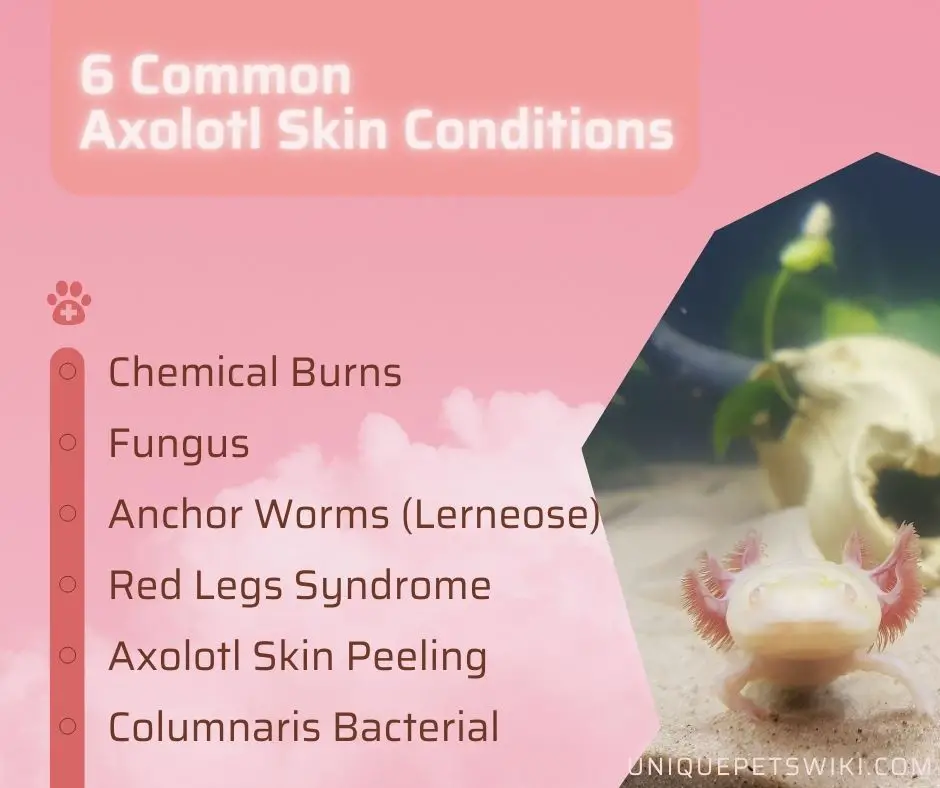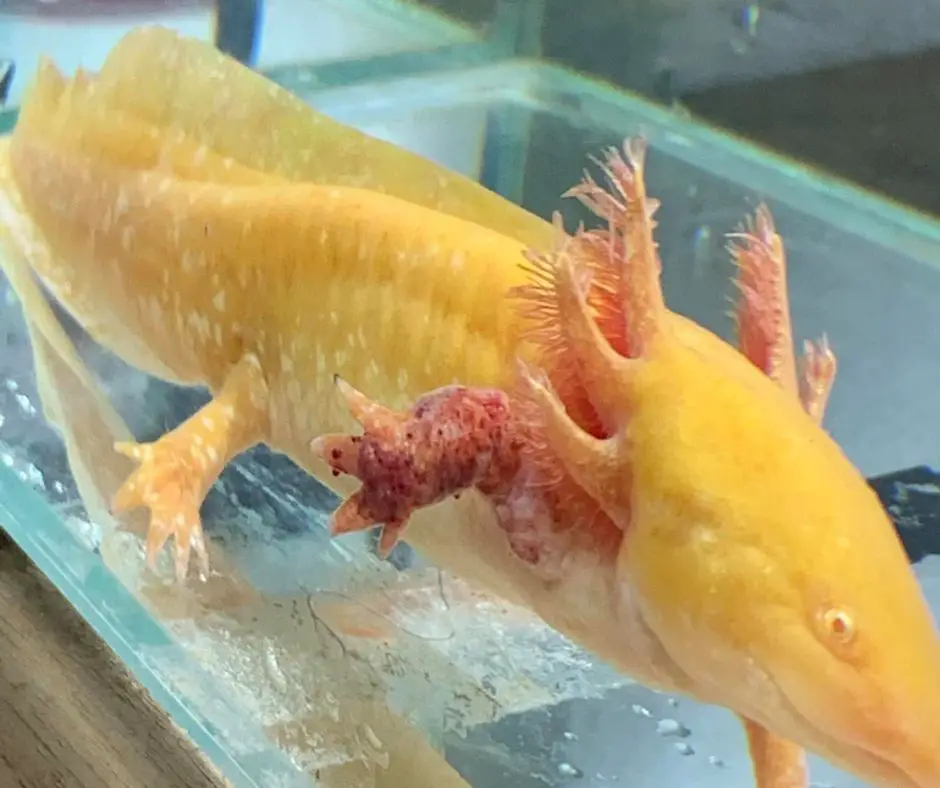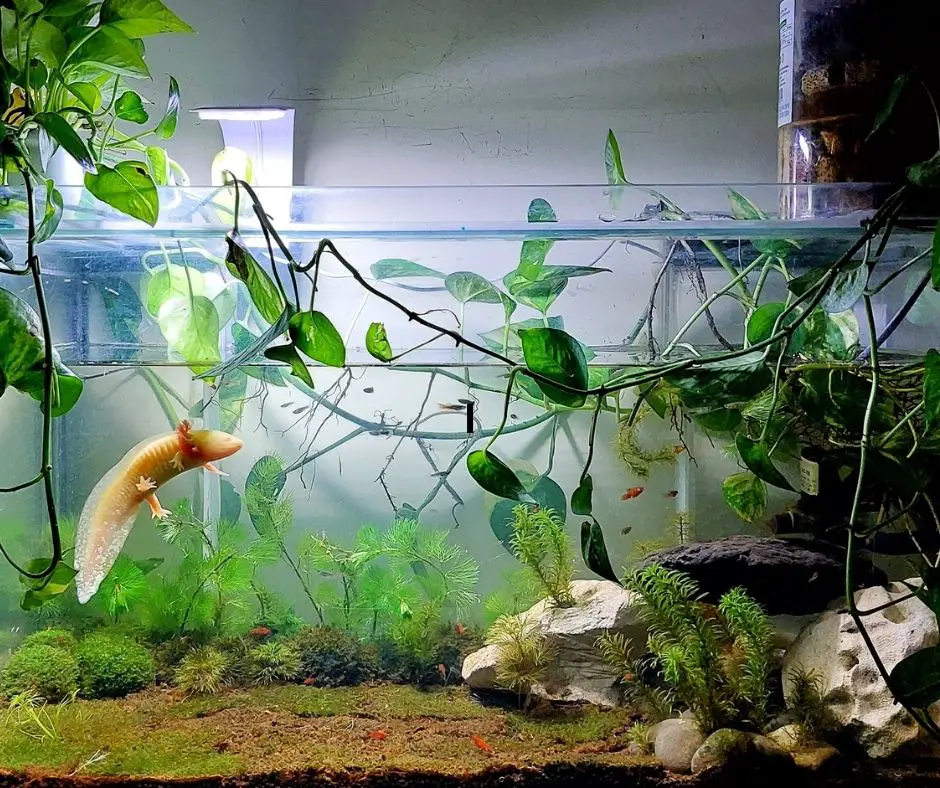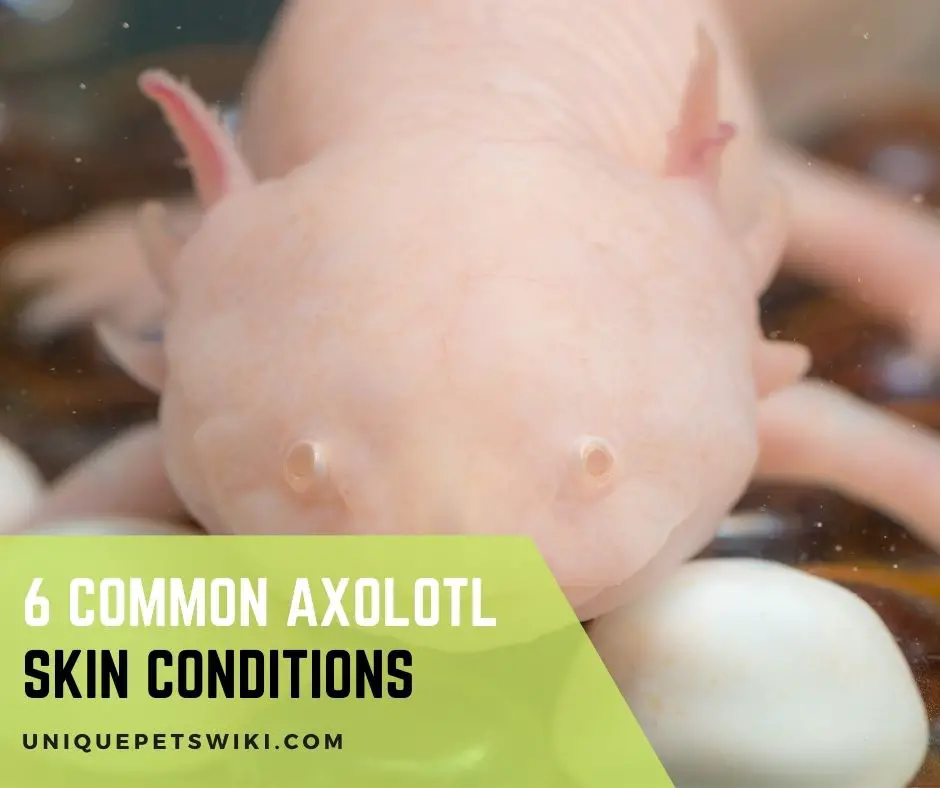Axolotls have a fairly strong immune system, and they do not easily succumb to diseases. If you are reasonably serious about care and maintenance, your little dragon will be fine in the tank.
However, these salamanders, like other aquatic animals, can get sick. In particular, they are prone to several skin conditions.
Many axolotl owners worry when their axolotls show symptoms of skin diseases. The good news is most of these diseases are curable.
And if housing and diet conditions are met, your axolotl will be less likely to have these problems in the first place.
In this post, we are going to discuss 6 common axolotl skin conditions, their causes, signs, and treatment methods.
Here you will also find answers to some frequently asked questions about common skin conditions of axolotls.
Contents
6 Common Axolotl Skin Conditions
If the living conditions in the tank are not standard, your axolotl may be prone to skin conditions.
However, these diseases may occur even if you are very careful about the overall well-being of your axolotl.
Chemical burns, fungus, anchor worms, red leg syndrome, skin peeling, and columnaris bacterial are the 5 most common axolotl skin conditions.

1. Chemical Burns
Ammonia is a naturally occurring chemical, and strong concentrations of it in the tank can kill your axolotl in just a few days.
Signs of chemical burns in axolotls include red patches on the skin, loss of appetite, loss of gill filaments, floating more than usual, curled tail at the tip, hemorrhage, and panic-stricken swimming.
The gas may result from the waste products that your axolotl releases. Decomposition of dead aquarium plants, algae, and leftover food waste can contribute to a spike in ammonia in the tank.
Biofilter damage can also be a reason for this problem.
Chemical burns in axolotls is a serious problem that requires addressing the underlying cause.
As soon as you notice the signs and symptoms, keep your axolotl in a new tank, and clean the contaminated tank. Consider using a pH adjuster to neutralize the ammonia levels in the tank.
Also, subject your amphibian pet to a tea bath. This simple treatment can eliminate the burns within a couple of days.
pH levels determine the concentration of ammonium. The concentration of ammonia increases as the pH rises.
The ammonium in the water turns toxic when the pH level rises above 9. Toxic ammonia, which is known as NH3, can kill your axolotl.
To prevent the condition from occuring in the first place, maintain zero ammonia levels in the axolotl tank.
An ammonia test kit can help you detect ammonia levels in the tank water. If ammonia concentrations are detected, lower the pH levels by doing a 50% water change.
Other ways to reduce or remove NH3 include improving the filtration, increasing aeration, using a larger tank, keeping live plants in the tank, and adding and preserving beneficial bacteria.
You may also consider using an ammonia neutralizer. It will not remove ammonia from the tank but make the existing ammonia concentrations harmless.
Also read: pH for Axolotl and Tips to Maintain
Aqueon Ammonia Neutralizers
- Neutralizes harmful ammonia and nitrites that can build up in aquarium water
- Also acts as a water conditioner, neutralizing chlorine and chloramines
- For freshwater and saltwater aquariums
- To reduce ammonia build-up, avoid overcrowding or overfeeding and perform regular partial water changes
- Convenient dosage cap is included - Add 5mL (1 tsp) per 10 gallons of water
Last update on 2022-12-29 / Affiliate links / Images from Amazon Product Advertising API
2. Fungus
Saprolegnia and columnaris are the most common fungi that infect axolotls. These fungi thrive in cool waters, and that’s why axolotls are at risk.
Typically, fungus looks like cotton-like fluffy tufts on the skin of axolotls. Gills and wounded body parts are more likely to suffer fungal infections.
Gill fungus causes the gill stalks to turn cloudy or whitish. Due to the infection, gill filaments may gradually degenerate.
Columnaris, which is actually a bacteria and not a fungus, causes similar problems in axolotls. If fungus infections are left untreated, they can get lethal.
Improper water parameters or poor water conditions may weaken your axolotl’s immune system, making the animal prone to developing fungal infections.
Fungus may result from high levels of dissolved organisms. If there is inadequate recycling of nutrients, and if water is not recycled regularly enough, your axolotl may have to deal with fungus outbreaks.
Salt baths, antibiotics, and antiseptics are some available treatment options for fungal infections. Tea baths can also be effective.
If fungus issues are very light, use Indian almond leaves. Unless the issues are too persistent, try not to use strong medications because they are unsafe for axolotls.
Changing the water on your axolotl tank regularly is the best way to prevent fungal infections. Also make sure your axolotl does not get injured.
Also read: Types of Axolotl Bath: Complete Guide for Beginner
3. Anchor Worms (Lerneose)
Anchor worms are parasites that attack freshwater fish including axolotls. To some extent, the parasite’s reproduction depends on water salinity.
Anchor worms have a complex life cycle, and can reproduce only in freshwater bodies. These small parasites are white or red in color, and measure just a half millimeter.
Anchor worms usually come with small fish or shrimp that you put into your axolotl’s tank. How do you know if anchor worms have infected your axolotl? Well, you will see them.
The main symptoms also include difficulty breathing and loss of appetite. If the gills are affected, your axolotl will scratch the gills against objects in the tank.
If your axolotl has anchor worms, hold the animal with a wet tissue and then remove the worms one by one.
Use betadine to disinfect the infected area. If there are eggs on the skin, betadine will remove them.
Before you introduce shrimp or small fish in the tank, check them carefully. Consider putting them in quarantine before introducing them in the tank.
Also read: Can Axolotl and Ghost Shrimp Live Together?
4. Red Legs Syndrome
Red legs syndrome in axolotls is caused by a bacterium called Aeromonas hydrophila. It is found in contaminated water or food. It can also be airborne.
The bacteria can be deadly and highly contagious. Once your axolotl has been infected, its legs and body will turn reddish. Symptoms also include bleeding from the skin and eyes, weight loss, and anemia.
The animal may become lethargic. Gradually the infection will spread throughout the body, and in severe cases it can cause death.
If there are unaffected axolotls in the aquarium, immediately take them out and keep them in a separate tank.
Take the affected axolotl to a veterinarian without delay. The vet will inject an antibiotic. At an advanced stage, the disease will get incurable, and your axolotl will die.
That’s why it’s important to take measures to prevent red leg syndrome. Before you introduce fish, shrimp or another axolotl in the tank, keep it in a separate tank for a week.

5. Axolotl Skin Peeling
Normally, axolotls do not shed their skin. So, if you notice that your little dragon is shedding its skin, there is something wrong with the animal, the water in the tank, or both.
The most common causes of this condition are chlorine, stress, heavy metals, high ammonia levels, water temperature and pH, and fungi.
Axolotls actually do not shed their skin; they shed their slime coat, which protects the skin, keeps it most, and regulates the body temperature.
In order to offer the best treatment, you have to identify the underlying reason first.
In most cases, dropping some almond leaves into the water can resolve the problem, or at least reduce the intensity of the problem. You may also consider subjecting your axolotl to a tea bath.
A salt bath can also be helpful, but it will hurt your axolotl. So, do not try this treatment unless absolutely necessary.
If tap water is used in an axolotl tank, chances are that there is too much chlorine in the water. It may be responsible for the condition. To revolve it, just allow the water to sit for a day or so. The chlorine will gradually dissipate.
Also read: Axolotl Shedding Slime Coat: 4 Common Causes and How to Prevent
6. Columnaris Bacterial
Columnaris is a species of bacteria that looks like fungus to the naked eye. Infections by this bacteria are treatable if they are diagnosed soon enough.
However, if left untreated, the complications can kill your axolotl.
The symptoms include white or fluffy gray patches, loss of appetite, and lethargy.
Columnaris infection is somewhat opportunistic, and stress can aggravate the symptoms. The bacteria can attack weak and old axolotls.
The best way to prevent the condition is to ensure proper environmental conditions. Before you introduce new inhabitants to the tank, make sure you quarantine them.
While the condition can be deadly in some cases, there are some effective treatments for it.
Salt baths and antibiotics can be pretty effective, but try to avoid them if you are not sure that the condition is actually caused by Columnaris bacteria. A qualified veterinarian can help diagnose the condition.
Tips to Keep an Axolotl Healthy

Axolotls are easy to care for. Every axolotl owner should know what these salamanders need for their overall well-being. Below are some tips that you may find helpful.
The most important thing is to keep an eye on water parameters. For axolotls, the optimum water temperature is 16-18°C. Make sure the water temperature does not exceed 24°C.
pH level should be between 7.4 and 7.6. Do not add chlorinated water to the tank. But if you must, leave the water to stand for a day before you add the water to the tank.
Change the tank water regularly. Remove about 50% of the tank water every week. Replace the stale water with fresh water.
Avoid overfeeding your axolotl. Overfeeding will lead to digestive problems. It can cause obesity and impaction. In some cases, overfeeding can even be fatal.
Also, avoid overcrowding. If you put too many axolotls in the tank, the salamanders may start nipping at each other’s gills.
If they are wounded, the wounds will become infected, and that will lead to serious complications. Overcrowding will also contaminate the water, and that will affect the overall well-being of the axolotls.
Ensure a stress-free environment for your little dragon. Place the tank in a vibration-free, quiter area. Exposure to direct light can be stressful for axolotls. To reduce the stressing effect, consider using LED lighting.
Axolotls have soft, delicate bodies with permeable skin. Therefore, unless absolutely necessary, do not handle your axolotl. Avoid touching your axolotl.
Regularly monitor the overall health and well-being of the animal. If there are signs of disease or changes in the animal’s behavior, take actions without delay.
API pH Down pH Adjuster
- For freshwater aquariums
- Lowers pH levels
- Safe for fish and plants
Last update on 2022-12-29 / Affiliate links / Images from Amazon Product Advertising API
Wrapping Up
While some skin conditions can be deadly for axolotls, most of these conditions can be prevented or cured.
Keep the tank water clean, change the water regularly, and see if your axolotl looks healthy and normal.
And if you notice the signs and symptoms of skin diseases in your pet, don’t panic.
Take measures as advised above, and your little friend will recover soon. If the symptoms are intense and primary treatments don’t work, contact a veterinarian.


